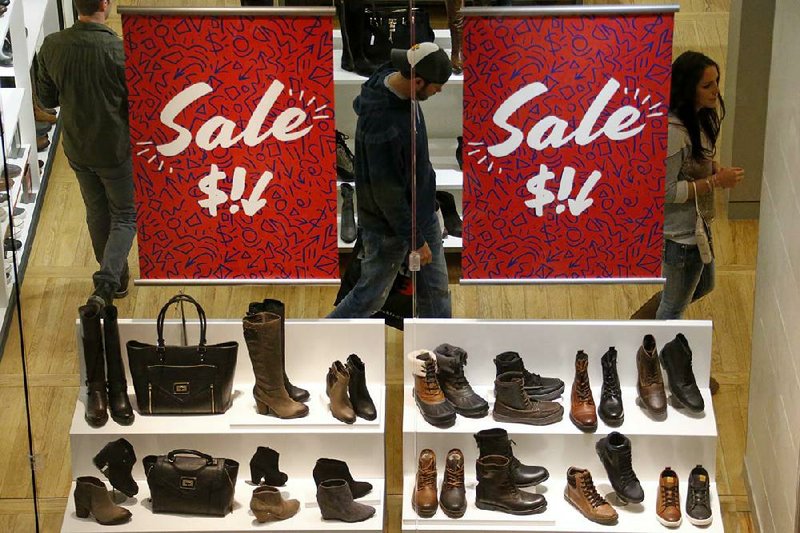Retail sales in the U.S. fell in January by the most since June 2012 as winter weather kept consumers away from auto showrooms and stores.
The 0.4 percent decrease followed a revised 0.1 percent drop in December that was previously reported as an increase, the Commerce Department said. The median forecast of 86 economists surveyed by Bloomberg called for no change. Sales excluding automobiles were unchanged.
Some Americans stayed closer to home, limiting trips to car dealerships and malls, as colder-than-normal temperatures and snowfall gripped parts of the nation. Job growth and wage gains the past two months also slowed, indicating consumers may have trouble maintaining the pace of spending after the fastest increase in three years in the final quarter of 2013.
“It’s not looking good for consumer spending,” said Guy Berger, U.S. economist at RBS Securities Inc. in Stamford, Conn. “Even if you have some modest improvement in the pace of employment growth, that’s not enough to generate a huge improvement in income.”
Estimates in the Bloomberg survey ranged from a decline of 0.5 percent to a 0.4 percent gain. The reading for the previous month was revised from an initially reported 0.2 percent increase.
January was the coldest in three years, with snowfall almost four times above normal, according to weather-data provider Planalytics Inc. That followed the coldest December since 2009 with snowfall 21 percent above normal.
Wal-Mart spokesman Dianna Gee said the company doesn’t discuss monthly revenue, particularly this close to the company’s quarterly and year-end earnings release, which is scheduled for Thursday.
“We’ve obviously been impacted by the weather, but our stores have been back up and running pretty quickly,” she said.
“Our stores have been extremely busy.”
The company has its own meteorologist, so when winter weather is pending, orders for needed items can be rushed to the stores.
“Customers have what they need at the right time,” Gee said.
Nine of 13 major categories showed sales declines last month, led by auto dealers, sporting-goods stores and apparel outlets, the Commerce Department’s report showed.
Sales slumped 2.1 percent at automobile dealers, the most since October 2012, after a 1.8 percent decrease the previous month.
Automakers said adverse weather depressed vehicle deliveries, which have been a bright spot for consumer spending in this expansion. Cars and light trucks sold at a 15.2 million annualized pace in January, slowing from a 15.3 million rate in December that had helped cap the best year for the industry since 2007, according to Ward’s Automotive Group.
Sales slid 12 percent for General Motors Co. and 7.5 percent for Ford Motor Co., the two largest U.S. automakers, while Toyota Motor Corp. and Honda Motor Co. also reported lower U.S. sales than analysts estimated.
“January got off to a pretty slow start with really inclement weather in the heartland of the country, all the way down into Texas,” John Felice, U.S. sales chief for Dearborn, Mich.-based Ford, said during a Feb. 3 conference call. “As things improved around the country midmonth, we saw a bounce back in demand and sales, which was encouraging. Then, sadly, the last week of the month we saw again another arctic blast.”
Retail sales excluding autos were unchanged after a 0.3 percent gain in December that was weaker than initially reported, the Commerce Department’s data showed.
Spending decreased 0.9 percent at clothing chains and 1.5 percent at department stores.
Purchases fell 0.6 percent at furniture outlets and 1.4 percent at retailers of sporting goods, books and music.
Sales climbed at electronics stores, building materials outlets, gasoline stations and grocery chains.
Purchases excluding merchants such as food services, car dealers, hardware stores and service stations - which are the figures used to calculate gross domestic product - fell 0.3 percent after a revised 0.3 percent increase in the previous month that was smaller than initially reported.
Thursday’s report shows spending is cooling after a pickup in the final three months of 2013 as the labor market struggles to improve. Household purchases grew 3.3 percent in the fourth quarter, the biggest gain since the end of 2010, Commerce Department data showed Jan. 30. The economy expanded at a 3.2 percent annual rate.
Information for this article was contributed by Lorraine Woellert and Chris Middleton of Bloomberg News.
Business, Pages 27 on 02/14/2014

